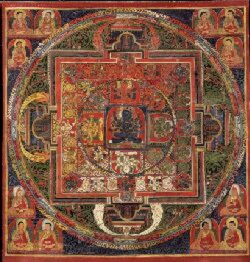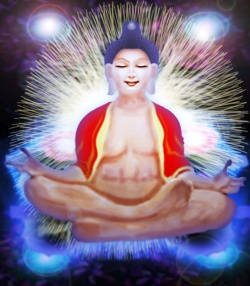The term, Emptiness, does not mean Nothing
It is crucial to understand that the term, Emptiness, does not mean Nothing.
Saraha: "The root of everything in existence and beyond is, oh yes it is, it is Mind"
Maitripa: "All phenomena are one's own mind.
Seeing external objects is the deluded mind.
They are empty of essence, like a dream."
Orgyenpa: "All phenomena are like reflections.
To think that they are real is missing the point
All of existence is mind's dance and play
To turn it into objects is uncool
Every single thing is a magic illusion
To think there's something there is being a fool!"
Alan Wallace: ". . . phenomena are dreamlike; there is no substantial reality that accords with appearances.
We observe phenomena as being far more concrete and tangible than in fact they are, and this is misleading. It occurs because of the mental process of reification.
Sechibuwa explains that there is no entity apart from the mind that is anything more than a deceptive appearance to the mind.
Nothing exists independently of consciousness or mental designation. "
How it is that we get the impression the world and everything in (and outside it) is Real is debatable, however.
There are a number of interesting and convincing Buddhist philosophical views.
They can be classified into four main categories: Vaibhasika, Sautrantika, Yogachara, and Madhyamika.
One System, Four Stages
In a rimay or ecumenical spirit, there is a tendency to view these 4 rather distinct views as one system with four stages.
That is because, as Todd Fenner says, "the definition of 'selflessness' becomes subtler and subtler and so the schools serve as a bridge or a ladder.
The notion of doing it this way is reinforced by the Hevajra Tantra which explicitly advises one to progress in this fashion."
If we entertain that idea, then 1 and 2 below correspond to the Hinayana, and 3 and 4 to the Mahayana.
1. Vaibhasika has been called "direct realism." It is similar to the first few of the Indian views that see the World of Experience as composed of various physical elements that interact with the components of beings.
2. Sautrantika considers that awareness is merely representational.
These first two schools consider that there are two kinds of interactors: Physical aspects, ie. skandhas of which one, rupa comprises the traditional elements, and the Mental aspects including consciousness (vijnana), sensation (vedana) which contributes to pain/pleasure, cognition (sanjna) and the impressions derived from experience (samskara.) See the 12 Links of Causality.
Chittamatra is often given as the 3rd, and a variant of it is:
3. Yogachara [older spelling: yogacara] sometimes referred to as the Knowledge Way or Vijnanavada. It has also been called Subjective Realism, acknowledging that individual factors including karma contribute to an experience of reality that must be different for everyone. It mentions the idea of "Buddha nature." Vasubandha and Asanga finally adopted this position.
4. Madhyamika basically holds that there is no ultimate reality in the sense that something exists apart from the experiencer, but that does not mean there is nothing at all. It turns around the definition of Shunyata and therefore has been called Sunyatavada or "voidism." Nagarjuna and Aryadeva are the main proponents. Chandrakirti expounds upon Nagarjuna.
Sometimes people do not see the views as organized in that distinct way. For example, Prasangika, Yogacharya and Svatantrika have been considered kinds of Madhyamaka.
In any case, the Madhya- or Middle Approach has given rise to the two main interpretations: Rangtong (Tibetan for Other-Empty) and Shentong (or, Zhentong -- Self-Empty.)
Rangtong-ism uses a positive or pragmatic approach, teaching that we can do something, and provides clear step-by-step instructions on how to attain the Objective.
Shentong-ism, which speaks of Buddha-nature, is more concerned with not striving, with dropping or not repeating, so that one's intuition, which is beyond concept and elaboration, can do its work.
Many would say that they are different modes of the same thing but from different perspectives -- different circumstances and usages. Dudjom Rinpoche explained the usage of the two positions like this:
"The Madhyamaka of the Prasangika and the Svatantrika is the coarse, Outer Madhyamaka.
It should indeed be expressed by those who profess well-informed intelligence during debates with extremist Outsiders, during the composition of great treatises, and while establishing texts which concern supreme reasoning.
However, when the subtle, inner Madhyamaka is experientially cultivated, one should meditate on the nature of Yogacara- Madhyamaka."
A Variation on the Classification
Venerable Lama Zopa in Virtue and Reality, IV:
"There are four schools of Buddhist philosophy;
Vaibhashika (che-tra-mra-wa),
Sautrantika (do-de-pa),
Cittamatra (sem-tsam) and
Madhyamika (u-ma-pa).
The fourth of these is the Middle Way school and is divided into two:
Svatantrika (rang-gyu-pa) and
Prasangika (thal-gyur-wa).
According to the Prasangika school, the object of refutation (or negation, gag-cha) is an extremely subtle object that is ever so slightly more than—a little over and above—what is merely labeled by the mind.
The object of refutation is what appears to us; it is that in which we believe. "
The Two Truths
Chandrakirti (Tib. Dawa Drakpa) was an early 7th-century disciple of Nagarjuna, who became the abbot of Nalanda University.
He explained:
". . . the Transcendent Conqueror presented the two truths with respect to all inner and outer things, like sprouts and everything else.
Genuine truth is described as being simply the authentic object of the noble ones' original wisdom that sees what is authentic and true; there is no identity actually established there for conceptual mind to find.
Relative truth is the false object seen from the perspective of the conceptual mind whose eye of wisdom is completely covered by the cataract of ignorance, as is the case with ordinary beings. It is therefore posited as being this conceptual mind. The object perceived does not exist in the way that this mind perceives it to be.
Thus, the Teacher explained that every thing found holds two natures within: a genuine nature and a relative one.
From among these two, the object of the noble ones' authentic vision is the precise nature of reality, genuine truth, and the object of false seeing is relative truth."
~ The Moon of Wisdom: Chapter Six of Chandrakirti's 'Entering the Middle Way' with Commentary from the Eighth Karmapa Mikyo Dorje's 'Chariot of the Dagpo Kagyu Siddhas.' trans. Ari Goldfield, Jules Levinson, Jim Scott & Birgit Scott, guided by Khenpo Tsultrim Gyamtso Rinpoche (Snow Lion Publications, 2006.)
Khenpo Tsultrim's explanation that also elaborates on Zhentong (or, Shentong.)
The Truth -- according to Prasangikas
The 14th Dalai Lama, Tenzin Gyatso Rinpoche in The World of Tibetan Buddhism: An Overview of Its Philosophy and Practice. Boston: Wisdom Pub., 1995. (49-54):
"According to the explanation of the highest Buddhist philosophical school, Madhyamaka-Prasangika, external phenomena are not mere projections or creations of the mind. External phenomena have a distinct nature, which is different from the mind.
The meaning of all phenomena being mere labels or designations is that they exist and acquire their identities by means of our denomination or designation of them.
This does not mean that there is no phenomenon apart from the name, imputation, or label, but rather that if we analyze and search objectively for the essence of any phenomenon, it will be un-findable.
Phenomena are unable to withstand such analysis; therefore, they do not exist objectively.
Yet, since they exist, there should be some level of existence; therefore, it is only through our own process of labeling or designation that things are said to exist... .
Except for the Prasangika school, all the other Buddhist schools of thought identify the existence of phenomena within the basis of designation; therefore, they maintain that there is some kind of objective existence . . . .
Since the lower schools of Buddhist thought all accept that things exist inherently, they assert some kind of objective existence, maintaining that things exist in their own right and from their own side.
This is because they identify phenomena within the basis of designation.
For the Prasangikas, if anything exists objectively and is identified within the basis of designation, then that is, in fact, equivalent to saying that it exists autonomously, that it has an independent nature and exists in its own right ... .
This is a philosophical tenet of the Yogacara school in which external reality is negated, that is, the atomically structured external world is negated.
Because the proponents of the Yogacara philosophical system assert that things cannot exist other than as projections of one's own mind, they also maintain that there is no atomically structured external physical reality independent of mind.
By analyzing along these lines, Yogacara proponents conclude that there is no atomicly structured external reality.
This conclusion is reached because of not having understood the most subtle level of emptiness as expounded by the Prasangikas.
In fact, Yogacarins assert that things have no inherent existence, and that if you analyze something and do not find any essence, then it does not exist at all.
Prasangikas, on the other hand, when confronted with this un-findability of the essence of the object, conclude that this is an indication that objects do not exist inherently, not that they do not exist at all.
This is where the difference lies between the two schools."
Shentong and Rangtong
The 16th-century Bengali scholar, Taranatha (so-named after his devotion to Tara,) was not only a great historian and practitioner who in later life traveled to teach in Mongolia, but was one of the foremost proponents of a view associated with the now absorbed Jonang school of Himalayan Buddhism.
This denomination bridged the Kadampa (or, Gelugpa) and the Kagyupa views.
The former promotes the rang-tong (self-emptiness) doctrine as expounded by Nagarjuna, Chandrakirti, and other Indian teachers.
The latter holds to shen-tong (other-emptiness.)
Shen-tong asserts that Emptiness, "in dispelling the illusive relative truths of the world, reveals an ineffable transcendental reality with positive attributes."
Rang-tong holds that Emptiness is "merely the elimination of falsely imagined projections upon the relative truths of the world and does not imply anything else."
Stephen Batchelor says further that "While such distinctions may strike us today as theological hairsplitting, in Tibet they became (and still are) crucial articles of faith."
Lama Karma Sherab of the Jamgon Kongtrul labrang (Pullahari, Nepal) insists that it must be emphasized that ultimately there is no difference between the two.
Indian Philosophy: the context for Buddhist views
Nagarjuna
On the originality of Madhyamika philosophy: somewhat technical.
The Gelugpas (or, Kadmapas) maintain this approach.
Buddha Heart, Buddha Mind gives the Dalai Lama's opinion on questions concerning this, the orthodox or Gelugpa (Rangtong) perspective, and related topics.
Shentong or Rangtong?
A Theosophy site has an interesting exposition of the 2 views.
___________________________________________________________________
Object of Refutation: one possible technique for searching for truth is to employ the process of elimination, and see what is left.
Therefore, the principle or topic under consideration may be called the object of refutation which helps keep in our mind the notion that the thing is not to be assumed to exist.
It is merely a target, so to speak.
Karl Popper (1902-1994) the foremost western philosopher in the field of knowledge was a proponent of this method, especially with regard to scientific research. He held that the more severe the test to which a theory can be subjected, and by means of which it is then either found to be false or to be true, is all-important to the [strength of the] truth discovered.
Jonang: Dolpopa Sherab Gyeltsen (1292-1361) is generally credited with developing the Jonangpa belief system.
like sprouts: Things which are a stage in development on the way to something that may seem to be wholly other.
A traditional example, like the mango tree that is huge and bears fruit, but it is the issue of (in this case) a relatively small seemingly-inert nut or seed.






